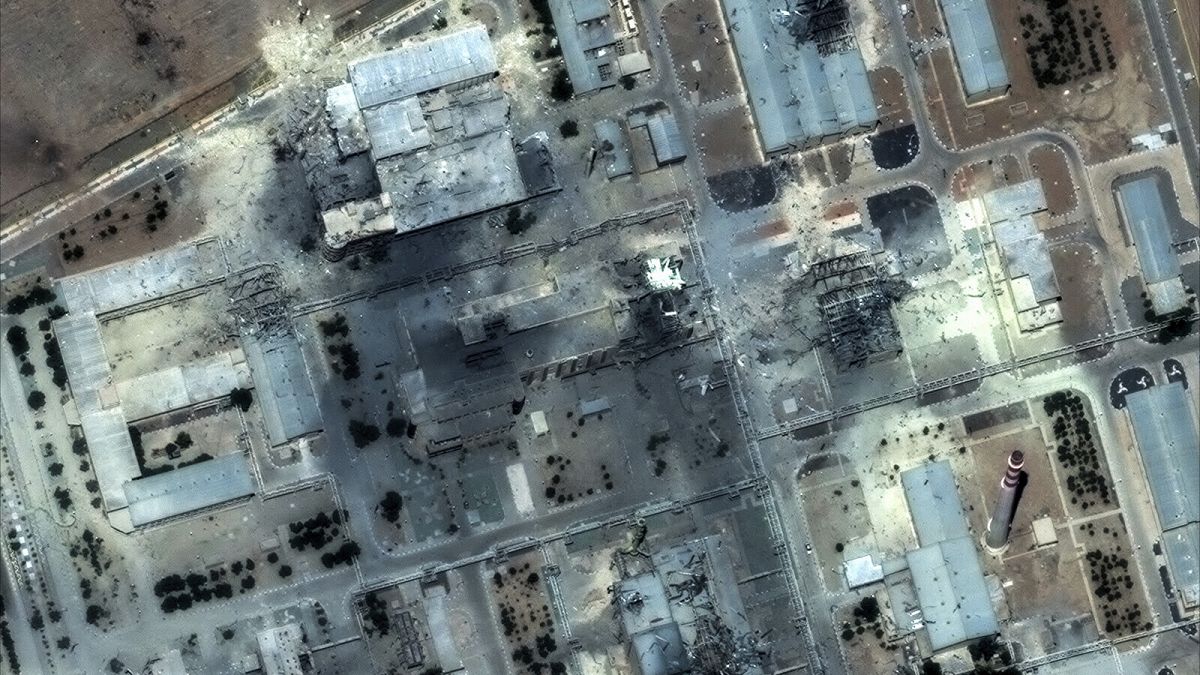President Donald Trump has said that US strikes overnight on Sunday have “completely and totally obliterated” Iran’s three flagship nuclear facilities at Fordow, Natanz and Isfahan.
Yet Dan Caine, who presides over the US’ military chiefs, refrained from drawing firm conclusions on Sunday, saying it would “take some time” to fully assess the extent of the damage.
Officials in Tehran have downplayed the impact of the airstrikes on the country’s nuclear facilities.
The attack, dubbed Operation Midnight Hammer, involved 125 US military aircraft, including seven B-2 stealth bombers carrying 14 bunker buster bombs weighing a staggering 13,000 kg each. In parallel to the aerial bombings, a US submarine launched as many as 30 cruise missiles.
Fresh satellite images now provide a first glimpse into the aftermath of the strikes.
They suggest significant damage has been inflicted on the facilities, supporting recent statements made by the chief of the International Atomic Energy Agency (IAEA) Rafael Grossi.
Experts say that while there is ample evidence of material damage, the setback to Iran’s nuclear programme is yet to be seen.
Signs of significant damage to Fordow’s enrichment halls
Fordow is Iran’s secretive enrichment plant buried deep inside a mountain 30km north of the city of Qom.
Only the US’ bunker-busting bombs – specifically their 13,000-kg GBU-59 Massive Ordnance Penetrators (MOPs) – were considered capable of penetrating into the mountain and damaging Fordow’s enrichment halls.
The GBU-59 can penetrate an estimated 18m of concrete or 61m of earth before exploding, while Fordow’s enrichment halls are believed to be buried as deep as 90m underground.
Post-strike satellite images provided by Maxar Technologies — a US space technology company — show six craters at the Fordow site, which experts at the US-based non-profit Institute for Science and International Security believe are penetration holes from the GBU-57 bunker-busting bombs.
They say the holes are “near the ventilation shaft of the underground complex, enabling an easier pathway for the MOPs (bunker busting bombs) to the deeply buried halls.”
These halls, sometimes referred to as cascade halls, contain a series of uranium-enriching centrifuges. According to the IAEA, Iran is believed to have been storing as much as 400 kg of uranium enriched to the near-weapons-grade level of 60% at Fordow.
The experts at the Institute for Science and International Security also note that tunnels leading to the halls were backfilled with soil in an apparent attempt by the Iranians to prepare for the attack.
“It is highly likely that the enrichment halls were severely damaged or even destroyed in the attack. Debris from the explosions can be seen on the side of the mountain,” they conclude.
Analysts at the London-based Open Source Centre (OSC) say images from Fordow suggest some of the “impact points” appear to be “directly above the main cascade hall.”
“Given the explosive payload utilised and the extreme(ly) vibration-sensitive nature of centrifuges, very significant damage is expected to have occurred,” IAEA’s Grossi said on Monday.
The UN nuclear watchdog has not yet been able to carry out inspections on the targeted nuclear facilities, and has pointed out that “no one” is currently able to fully assess the extent of the damage.
The agency is now demanding full access to the sites. Earlier this month, it accused Iran of failing to “cooperate fully” with its prior inspections.
While the photographic evidence points to considerable destruction, doubts have been raised as to whether Iranians had removed stockpiles of highly-enriched uranium from the Fordow enrichment halls immediately before the attack.
Satellite images show that as many as 16 trucks were stationed along the access road to the tunnel entrances at Fordow less than 48 hours before the attack, suggesting a last-minute scramble to move the uranium to an undisclosed site.
Natanz facilities ‘destroyed’, experts estimate
Natanz, believed to be the site of Iran’s largest nuclear enrichment centre, was also impacted by a GBU-57 bunker buster, according to experts’ analysis of satellite images.
“A clear impact penetration hole reportedly caused by a GBU-57 (MOP) can be seen just above the buried enrichment halls. This explosion likely destroyed the facility,” experts at the Institute for Science and International Security (ISS) said.
The site had suffered two previous strikes by Israel since the conflict broke out on 13 June.
Clear damage to over-the-ground facilities at Isfahan
The final site targeted in the US operation was the Isfahan Nuclear Technology Centre, believed to be home to hundreds of nuclear scientists and a key research centre for Iran’s nuclear programme.
Cruise missiles fired from the US submarine involved in the coordinated attack are reported to have struck both buildings and tunnel entrances at the facility.
Satellite images from the site show visible damage to the over-the-ground facilities. The site had already been targeted by Israeli strikes since the conflict broke out.
Experts at the Institute for Science and International Security say they believe a uranium conversion facility and tunnel entrances leading to an underground complex were destroyed at the site.
It is believed that, as in the case of Fordow, tunnels had been backfilled in an attempt to minimise damage and the dispersion of radioactive or polluting material as a result of the strike.
Yet Dr Jeffrey Lewis, an expert in nuclear non-proliferation and professor at the Middlebury Institute of International Studies, believes the strikes on Isfahan have failed to destroy the main tunnels believed to contain highly-enriched uranium at the facility.
It is highly likely that such material was transported from the Isfahan facility in the run-up to the attack, as in the case of Fordow, Dr Lewis added.
“We ought to judge this strike by its real purpose, not the legal camouflage of preemptive self-defense. If the strike leaves the current regime, or something very much like it, in power with a nuclear option then it will have been a strategic failure,” he said.
Kamuran Samar contributed to the visuals used in this report.

